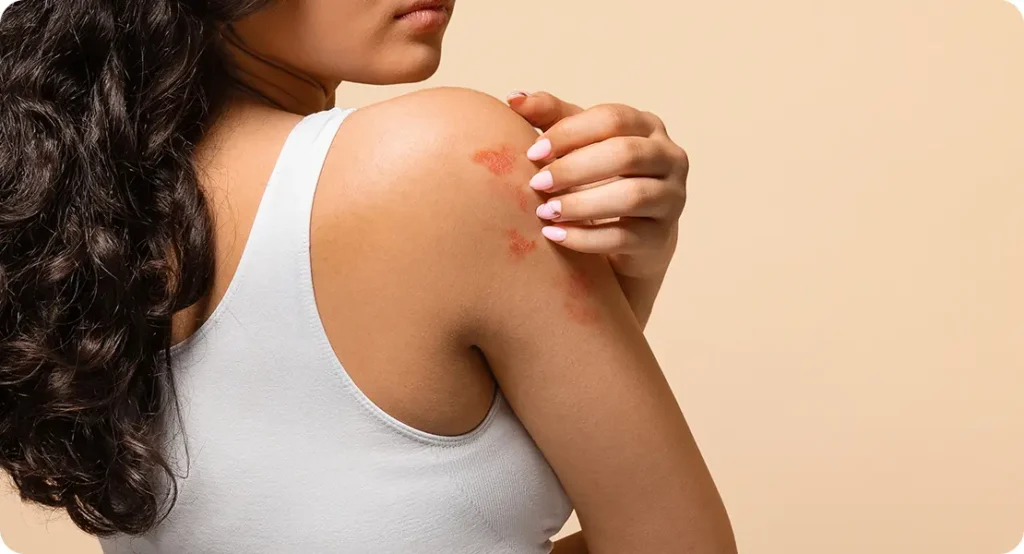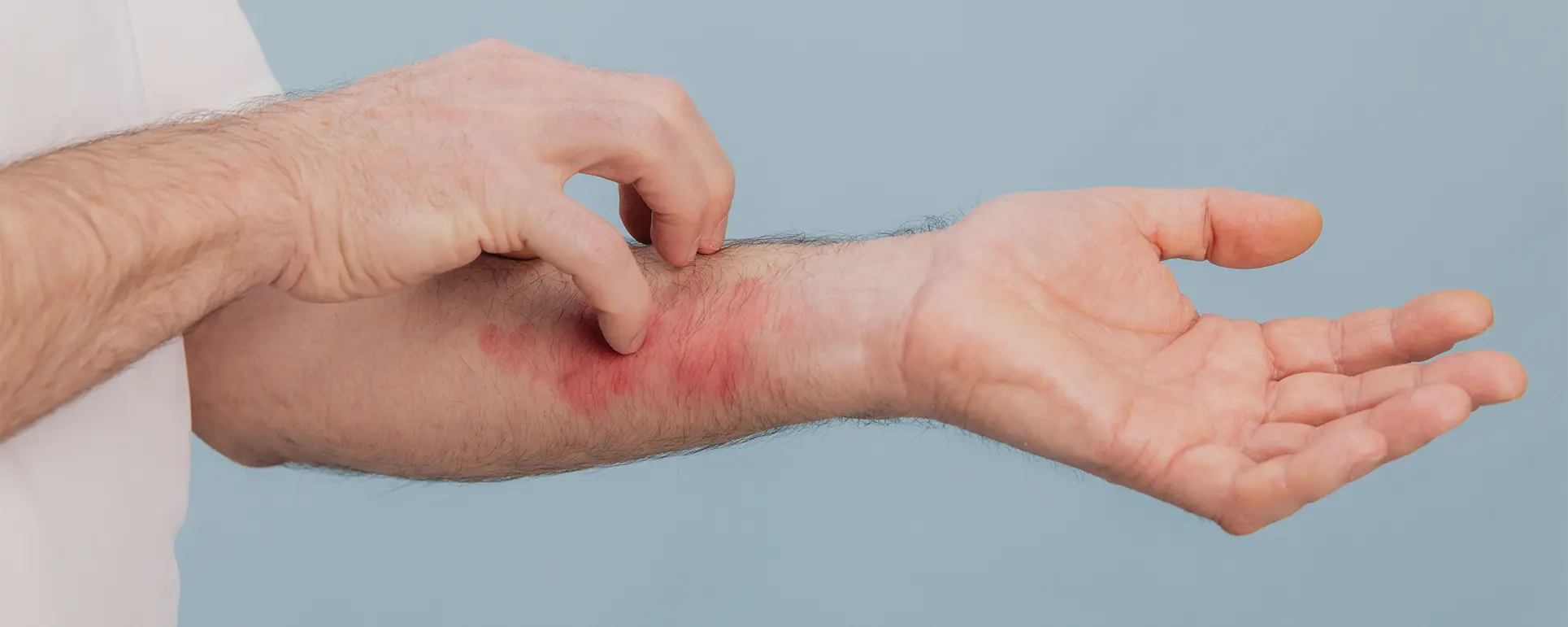We all get the occasional itch now and then. Most of the time, it’s nothing to worry about maybe a dry patch of skin, an insect bite, or a reaction to a new laundry detergent. A little lotion or time often takes care of it, and we move on with our day.
But what if you’ve noticed one itchy spot that just won’t go away, no matter what you try? It might be on your arm, your back, or your scalp, and it keeps coming back or never fully disappears. You find yourself scratching without thinking, or waking up at night because the itch has become impossible to ignore.
If that sounds familiar, you’re not alone. Many people search for answers about persistent itching in a single area of skin, especially when it starts interfering with sleep, daily comfort, or even your confidence when out in public. Sometimes, it turns out to be something minor and easily treated with a simple change in skincare or habits. Other times, a stubborn itch can be an early warning sign from your body that shouldn’t be ignored.
In this article, I’ll walk you through some of the most common reasons behind that stubborn itch, from dry skin and eczema to nerve-related causes and skin cancers. I’ll also help you understand when it’s time to get it checked by a dermatologist so you can get the right treatment and peace of mind.
When Is an Itchy Spot Considered “Persistent”?
Most of us expect itches to go away within a day or two, especially if they’re caused by something minor like dry skin or an insect bite. But when you have an itchy spot that sticks around for more than two weeks, it’s considered persistent, especially if it keeps returning, changes in appearance, or starts to interfere with your daily comfort.
Sometimes, a persistent itch may seem mild at first, but over time, it can become more noticeable, bothersome, or even painful. You may find yourself scratching the area repeatedly, only for the itch to return as soon as you stop. It may also wake you up at night, leaving you feeling frustrated and tired.
It’s important to watch for warning signs that could indicate something more serious than simple irritation:
- Itching that worsens over time instead of improving
- Changes in skin texture, such as thickening, scaling, roughness, or darkening
- Bleeding or open sores caused by scratching the same spot repeatedly
- Pain, burning, or tingling sensations in the area
- A visible lump or patch that is growing in size or changing shape
These symptoms don’t always mean something serious is going on, but they can sometimes signal underlying conditions like eczema, psoriasis, nerve-related itching, or even skin cancer. If you notice any of these changes alongside a persistent itch, it’s worth booking an appointment with your dermatologist to get it checked.
Common Causes of a Persistent Itchy Spot

While not every itchy patch is a cause for alarm, it’s helpful to understand what could be behind an itch that just won’t go away. Knowing the possible causes can help you decide your next steps, whether that’s trying a home remedy, avoiding triggers, or booking a check-up with your dermatologist for peace of mind.
Below are some of the most common culprits behind persistent localised itching:
1. Lichen Simplex Chronicus
This is one of the most common causes of persistent localised itching. It’s essentially a cycle of itch-scratch-repeat: the more you scratch, the thicker and itchier the skin becomes, which then tempts you to scratch again.
What it looks like:
- Thick, leathery patch of skin
- Often darker than the surrounding skin
- Common on the neck, arms, ankles, or genitals
What causes it:
- Ongoing irritation, often triggered by stress, anxiety, or underlying eczema
- Frequent rubbing or scratching, even unconsciously during sleep
Treatment:
- Topical steroid creams to reduce inflammation
- Antihistamines for itch relief, especially at night
- Behavioural strategies to help break the itch-scratch cycle
2. Fungal Infections (Tinea or Ringworm)
Fungal infections can appear anywhere on the body and thrive in warm, moist environments, like skin folds or under tight clothing. The itching can be intense and often worsens at night.
What it looks like:
- Red, ring-shaped patches with a clearer centre
- Slightly raised or scaly edges
- May spread outward slowly over time
What causes it:
- Fungi, commonly spread through skin-to-skin contact
- Shared towels, gym mats, or locker room floors
Treatment:
- Over-the-counter or prescription antifungal creams
- Oral antifungal medications for more persistent cases
- Keeping the area clean and dry to prevent recurrence
3. Nummular Eczema

Nummular eczema is a type of eczema that causes round, coin-shaped itchy patches, often appearing on the arms or legs. The patches can come and go, sometimes linked to dry weather or environmental triggers.
What it looks like:
- Round, red or brown coin-shaped patches
- May ooze, crust, or become dry and scaly
- Can be intensely itchy
What causes it:
- Exact cause is unknown
- Often linked to dry skin, environmental irritants, or injuries like insect bites
Treatment:
- Regular moisturising to protect the skin barrier
- Prescription steroid creams during flare-ups
- Avoiding known irritants, harsh soaps, and hot showers
4. Psoriasis
While psoriasis often affects multiple areas, it can start with a single persistent patch. Psoriasis occurs when the immune system attacks healthy skin cells, speeding up skin cell turnover.
What it looks like:
- Thick, silvery-white scales
- Red, raised patches
- Common on the elbows, knees, scalp, or lower back
What causes it:
- Autoimmune condition
- Can be triggered by stress, infections, or skin injuries
Treatment:
- Prescription creams or ointments
- UV light therapy under medical supervision
- Systemic medications for more severe cases
5. Contact Dermatitis
Contact dermatitis happens when your skin comes into contact with something irritating or allergenic, causing a localised rash and itching.
What it looks like:
- Red, itchy rash
- May blister, ooze, or swell
- Appears shortly after contact with the irritant
What causes it:
- Irritants: soaps, detergents, cleaning products
- Allergens: perfumes, plants like poison ivy, metals like nickel
Treatment:
- Identifying and avoiding the trigger
- Using soothing creams, cool compresses, and moisturisers
- Prescription steroid creams for more severe reactions
6. Early Skin Cancer (Including Basal Cell Carcinoma)
Though less common, a persistent, itchy spot that doesn’t heal can sometimes be an early sign of skin cancer. It’s important not to ignore a spot that is changing, bleeding, or continuing to itch despite treatment.
What it looks like:
- A sore that doesn’t heal or repeatedly scabs over
- A patch that bleeds or keeps itching
- A shiny, pearly bump that slowly enlarges
What causes it:
- Damage to skin cells from ultraviolet (UV) exposure, such as sunlight or tanning beds
Treatment:
- Early detection is crucial for effective treatment
- Options include surgical removal, cryotherapy (freezing), or topical chemotherapy creams depending on the type and stage
When to See a Dermatologist

If you’re dealing with a stubborn patch of skin, it can be tempting to wait and see if it clears up on its own. But in many cases, early intervention makes a big difference not just for relief, but also for ruling out more serious concerns. Here’s when I’d strongly recommend booking an appointment with a dermatologist:
- The itching lasts longer than two weeks with no signs of improvement
Occasional itching isn’t unusual, but if it’s persistent and not getting better after two weeks, it’s time to get it checked out. Chronic itching can point to underlying skin conditions such as eczema, psoriasis, or even internal health issues. - The patch is painful, bleeding, or changing in size or appearance
Any skin lesion that hurts, bleeds, or starts to look different over time whether it’s growing, changing colour, or developing an irregular border should be examined by a professional. These are potential warning signs of skin cancer, and early detection is crucial. - Over-the-counter treatments haven’t worked
If you’ve tried moisturisers, anti-itch creams, or antifungal ointments with no success, it’s a good indication that you may need a stronger prescription treatment or a more accurate diagnosis. A dermatologist can help pinpoint the cause and recommend a tailored solution. - You notice multiple similar spots appearing
When one patch turns into several, especially in the same area or across different parts of the body, it could suggest a spreading condition like fungal infections, allergic dermatitis, or an autoimmune response. A dermatologist will help you understand what’s happening and stop it from progressing further. - You have a personal or family history of skin cancer or chronic skin conditions
If you or a close family member has dealt with skin cancer, melanoma, or long-term skin conditions such as rosacea or lupus, it’s wise to be extra cautious. Seemingly minor changes in your skin may carry more weight, and a dermatologist can help you stay ahead of any serious developments.
In general, if something about your skin just doesn’t feel right and it’s not improving it’s always better to seek professional advice. The earlier you take action, the more treatment options are likely to be available, and the better the outcome tends to be. Skin issues can escalate quickly, but with prompt care, most conditions can be effectively managed or resolved.
What to Expect During a Dermatology Visit
If you’ve never seen a dermatologist before, it’s completely normal to feel a bit unsure about what the appointment will involve. But rest assured, the process is simple, thorough, and focused entirely on helping you get answers and relief.
Here’s what typically happens during a consultation:
- A close examination of the itchy or affected area
Your dermatologist will start by visually inspecting the problematic area. They’ll look at the size, shape, texture, and any patterns in the rash or lesion. This hands-on assessment helps narrow down potential causes and gives them a better understanding of what you’re dealing with. - Questions about your medical history and skincare routine
You’ll be asked about any existing health conditions, medications you’re taking, allergies, and whether you’ve experienced similar symptoms in the past. They’ll also want to know about the skincare products you use at home, any recent changes in your routine, and how long the issue has been going on. - Tests like skin scraping, biopsy, or patch testing (if needed)
Depending on what they see, your dermatologist may recommend a few simple tests. A skin scraping can help check for infections like fungus or mites. A biopsy which involves removing a small sample of skin can help rule out more serious conditions such as skin cancer or autoimmune disorders. If they suspect a reaction to something in your environment, they might do a patch test to identify potential allergens. - Discussion of possible triggers in your environment or lifestyle
Sometimes, skin issues are made worse or even caused by external factors like stress, diet, weather, fabrics, or exposure to certain chemicals. Your dermatologist will talk you through any lifestyle habits or environmental triggers that might be contributing to your symptoms, and offer practical steps you can take to avoid them.
Once they’ve gathered enough information, your dermatologist will walk you through a personalised treatment plan. This could involve:
- Prescription-strength creams or ointments
- Oral medications to address inflammation, infection, or allergies
- Lifestyle recommendations
- Follow-up tests or imaging if a deeper issue is suspected
Most importantly, you’ll leave with a clear understanding of what’s going on and how to manage it moving forward. Whether your issue turns out to be something minor or a condition that needs ongoing care, having a plan in place can feel incredibly reassuring.
It’s a straightforward, supportive process and for many people, it marks the first step toward finally getting their skin back under control.
Home Remedies You Can Try (But Don’t Rely On)
If you’re waiting for your dermatology appointment or just trying to get through the day without scratching your skin raw there are a few simple steps you can take at home to relieve the discomfort. These remedies won’t replace medical treatment, but they may help ease symptoms temporarily and prevent things from getting worse.
Here are some gentle, dermatologist-approved strategies you can try:
- Apply a cold compress
Using a cool, damp cloth or an ice pack wrapped in a soft towel can provide immediate relief by numbing the area and reducing inflammation. Apply it for 10–15 minutes at a time, several times a day, especially when the itching becomes intense. Avoid placing ice directly on the skin, as that can cause irritation or even mild frostbite. - Use fragrance-free moisturisers
Keeping your skin well-hydrated is one of the simplest yet most effective ways to reduce itching. Choose a thick, fragrance-free moisturiser or emollient, ideally one that contains ceramides, colloidal oatmeal, or shea butter. Apply it generously after bathing and throughout the day as needed. Avoid scented lotions or those with alcohol, which can worsen irritation. - Avoid hot showers and harsh soaps
As tempting as a long hot shower might be, heat strips the skin of its natural oils, leaving it dry and more prone to itching. Instead, opt for lukewarm water and limit showers to 5–10 minutes. Use a mild, soap-free cleanser designed for sensitive skin, and pat your skin dry with a towel rather than rubbing it. - Wear loose, breathable clothing
Tight, synthetic fabrics can trap heat and sweat, making itching worse. Stick to soft, breathable materials like cotton and avoid wearing tight waistbands or scratchy seams. If your itchy area is on the arms or legs, wearing loose sleeves or trousers can help protect the skin from environmental triggers while preventing unnecessary friction. - Keep your nails short to avoid skin damage
Scratching might bring temporary relief, but it can also lead to broken skin, infections, and even permanent scarring. Keep your nails trimmed short and smooth to minimise damage if you do scratch in your sleep or unconsciously. In more severe cases, you might consider wearing light cotton gloves at night to prevent scratching while you sleep.
These home remedies can make your skin feel more comfortable and may even help reduce inflammation in the short term. However, it’s important to remember they are not a cure. If your itching doesn’t improve or begins to spread, worsen, or show other warning signs, don’t rely on home care alone.
The sooner you see a dermatologist, the sooner you can identify the root cause and get access to targeted treatments that actually work.
Final Thought: Don’t Ignore What Your Skin Is Telling You
It’s easy to dismiss an itchy spot as “nothing serious,” but when it sticks around for weeks or starts to change it’s your body’s way of saying something needs attention. From simple dermatitis to fungal infections or even early-stage skin cancer, there’s a wide range of causes that can all look deceptively similar. That’s why getting a professional opinion is so important.
You can get in touch with us to book a consultation with one of our expert dermatologists in London and take the first step towards relief and peace of mind.
References:
- Ju, T., Vander Does, A., Mohsin, N. & Yosipovitch, G., 2022. Lichen simplex chronicus itch: an update. Acta Dermato-Venereologica, 102, adv00796. Available at: https://www.ncbi.nlm.nih.gov/pmc/articles/PMC9677261
- Charifa, A., Badri, T. & Harris, B.W., 2023. Lichen simplex chronicus. In: StatPearls [Internet]. Treasure Island (FL): StatPearls Publishing. Available at: https://www.ncbi.nlm.nih.gov/books/NBK499991
- Leung, A.K.C., Lam, J.M., Leong, K.F., Leung, A.A.M., Wong, A.H.C. & Hon, K.L., 2020. Nummular eczema: an updated review. Recent Patents on Inflammation & Allergy Drug Discovery, 14(2), pp.146–155. Available at: https://pubmed.ncbi.nlm.nih.gov/32778043
- Robinson, C.A., Love, L.W., Saleh, H.M. & Farci, F., 2024. Nummular dermatitis. In: StatPearls [Internet]. Treasure Island (FL): StatPearls Publishing.
Available at: https://www.ncbi.nlm.nih.gov/books/NBK565878 - Criado, P.R., 2025. Chronic pruritus: a narrative review. Seminars in Cutaneous Medicine and Surgery, in press. Available at: https://www.sciencedirect.com/science/article/pii/S036505962500042X
